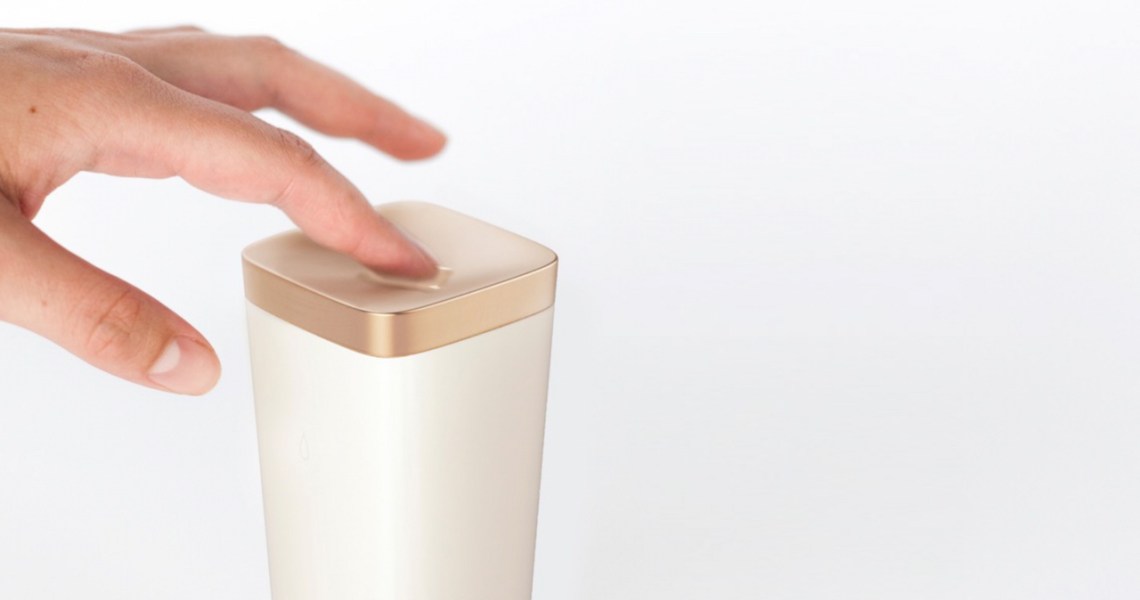L’Oréal is betting that mass adoption of personalized beauty products will require tech devices in the home.
On Sunday, the company debuted a new beauty device ahead of CES called Perso, which was developed by L’Oréal’s technology incubator, that will be able to dispense customized skin care, lipstick and foundation products within a customer’s home. Standing just over six inches tall and weighing one pound, the device is paired with an app that analyzes a user’s skin, uses geolocation data to determine environmental factors and allows a user to submit their specific preferences or skin concerns. After inputting that information, Perso dispenses a single-use amount of product. Perso will initially function as a skin-care device, before launching the foundation and lipstick functionality in the first quarter of 2021. It has yet to be determined what L’Oréal brand the device will be integrated with or what its retail price will be.
The device operates by inserting up to three product cartridges through the bottom, while the top has a motor system which blends and compresses the formula from the cartridges to dispense it through the top. Users operate the device through the Perso app.
“This is our way of bringing personalization to the consumer through [their] home,” said Guive Balooch, head of L’Oréal’s technology incubator. “We hope it unlocks a closer relationship between people’s skin and skin care, because it’s [customizable] like an at-home service.”
Earlier iterations of personalized devices from L’Oréal’s tech incubator, for brands including Lancôme and SkinCeuticals, required a customer to go to a store in order to experience the device and receive products. At SXSW 2018, Lancôme launched a device offering customized shades of its Le Teint Particulier foundation but required a customer to receive a consultation with a Lancôme sales associate. It is currently available in 28 store locations. In the summer of 2018, SkinCeuticals debuted a custom facial serum through an in-store device using a questionnaire that was also administered by a SkinCeuticals sales associate. The device is currently available at approximately 60 medspas and dermatology offices. L’Oréal’s only dedicated device brand, Clarisonic, sells at-home products but has faced issues in the past relating to a $263 impairment after not meeting sales expectations followed by layoffs in 2016.
Most brands have adopted an online quiz in order to provide customers with personalized product recommendations, but many are a basic form of personalization. Kenya Watson, CB Insights analyst, said she expects personalized products to move beyond quizzes to “hyper-personalized” segments such as catering to the specific microbiome of an individual.
“Personalization is a fast-rising trend in the beauty and personal-care industry; many customers are coming to expect beauty brands to offer some level of personalization. Once companies can make accurate personalizations, provide integrations with existing smart devices and make products at an accessible price point, we will see more of these at-home devices gain traction,” said Watson.
Ad position: web_incontent_pos1
For its part, Perso’s skin-care feature is able to detect deep wrinkles, dark spots, pore size through a L’Oréal Modiface integration, according to the company, and will allow users to select areas of concern to address, such as dullness or pigmentation. Modiface, acquired by L’Oréal in March 2018, has quickly sought to integrate the technology into brands like NYX and has also used it in partnerships with Facebook and Amazon.
Through a partnership with air-quality app Breezometer, Perso will consider environmental factors such as pollution levels, humidity and UV strength when formulating products. The makeup feature will have the capability to incorporate real-time trend information as well as color-matching technology into its products. Balooch said the device will be able to adapt to a user’s skin type and needs over time.
“The value comes out of personalization when you can make it inclusive; there are more consumer expectations than there are products on the shelf,” said Balooch. “Inclusivity is not just about a product, but it’s also about data. We can’t just make it about finding the perfect skin-care product, but [it has to get] better and adapt to a user’s environment.”
However, with every at-home device, the inevitable concern is that people will stop using it, which could hamper the widespread adoption of personalized products as both a concept and category. Other at-home device brands, like L’Oréal’s Clarisonic, have launched programs to encourage ongoing usage, while Paul Peros, former CEO of facial device company Foreo, said being a “last-drawer product” was his biggest fear.
“Whether or not a device is on the bottom or top of your shelf depends on how well it adapts to you and gets closer to what you need and evolves with you,” said Balooch. “If we launched this system four years ago when we didn’t have the system we have now, like the photo analysis or the ability to measure data, we couldn’t do it.”




